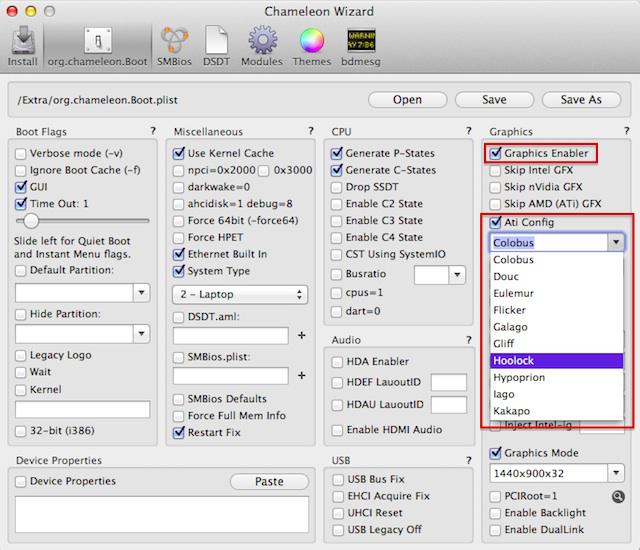-
Posts
10067 -
Joined
-
Last visited
-
Days Won
569
Content Type
Profiles
Articles, News and Tips
Forums
Everything posted by Hervé
-
You don't need SoundFlower, 'causes more trouble than good. Just use the STAC92xx kexts.
-
Did you specify any ATI Config value at all? Try those things that were suggested and report accordingly...
-
Try the attached kexts in /E/E then run myFix (quick). Needs a light finger to move the mouse pointer; a heavier finger does scrolling within the active page (by rolling up/down your finger tip, finger heavily down, without actually lifting the finger). Archive.zip
-
Try AtiConfig=Hoolock + GraphicsEnabler=Yes as manual Chameleon boot options (use exact same syntax and casing). If it works, just add them to your boot plist. Use Chameleon Wizard if you need assistance.
-
You're somehow mistaken. First of all, myHack does not provide support for any hardware per sé, it's an OS X installation tool. Hardware support is provided by drivers (i.e. kexts), patched DSDTs and/or SSDTs, patches, etc. myHack provides assistance in such drivers or files installation, nothing else. If you include the necessary drivers or suitably patched drivers in the bootpack, myHack will automatically support the related hardware. Clover is no different in that respect, it's just that it provides a lot more built-in features to cover hardware. It's therefore a lot richer but, also, a lot more complicated to understand. Secondly, current version of myHack does not support Yosemite installation. As such, you indeed have to resort to alternative methods to install Yosemite. Like Chameleon, Clover is a bootloader, not an installation or USB installer creation tool: it does not create the USB installer like myHack does for Mac OS X/OS X versions from SL 10.6 to Mavericks 10.9. myHack uses Chameleon as bootloader. Clover is installed on a USB installer once it has been created and it is also installed on the target partition once OS X has been installed on it. However, you can easily manually create your Yosemite USB installer, on which you then install Chameleon. There are tons of guides related to that on the usual forums, this one included (look here or here for instance). This manual method is basically what myHack more or less does in the background without users knowledge. It hides all the complexity to provide a nice and easy tool to the user. This being said, it's also nice to know the actual details, at least for educational purposes... To sum things up: Clover = sophisticated bootloader with built-in advanced hardware detection support; somehow difficult to understand / install / use Chameleon = goold old very reliable bootloader with limited hardware detection support. Very easy to understand / install / use myHack = OS X USB installer creation tool + advanced driver installation & management tool
-
Hi, a few questions: . which OS X version are you trying to install? . what are the problems you experience with myHack? I'm not a great fan of Clover (you need a Clover university degree to understand it in my opinion), so I tend to stick to myHack and Chameleon as much as possible.
-
You'll find it easier to use Chameleon Wizard, it offers a nice UI where you simply tick a case for 32bit kernel mode and then save the config in the boot plist.
-
https://osxlatitude.com/index.php?/topic/2120-supportedunsupported-wireless-cards-inventory/ Cards from Apple Macs are of course supported.
-

[HELP] How to patch DSDT/SSDT for Lenovo Y410p, How to fix some problems
Hervé replied to JSolorzano's topic in The Archive
Use Terminal command lspci -nn (need lspcidrv kext installed and loaded) to post us your exact system specs. Difficult to know what audio, Bluetooth or LAN hardware you have otherwise. Intel wireless cards are not supported so you'll have to replace your card by another model or use a USB dongle. USB3.0 ports are usually working once you add the generic USB3.0 kext. Alternatively, some systems just require the AppleHPET kext to be removed (it's known to affect USB3 functionality). Bluetooth may require a patch, depending on the hardware or it may be fixed with AppleHPET removal. Mobile Intel HD4600 is not natively supported by OS X (only the desktop version is) so you have to do some patching to obtain full graphics acceleration. There's a good thread about it on InsanelyMac forum or you can refer to existing Dell threads here on that same matter. You can start with my guide for the Latitude E6440 for instance. -
Corrupt download? Try with another copy or another version.
-
Look up the wireless card inventory in the relevant R&D->Hardware section of the forum.
-
With -x flag (safe mode), you'll probably be able to boot to desktop, without graphics support of course; but that can then be worked on...
-
Installation on an dual CPU-based Dell workstation is mentioned here. The "usual" method refered to is that detailed in the link I previously posted. In other words, there is no difference in the installation process whatever the targeted system, it's a "simple" matter of using the correct SMBIOS profile and, of course, Chameleon configuration parameters + appropriate kexts. You've mentioned the MacPro yourself in your last post, that was a good hint, so if you read the whole thread about the Dell Precision 670, you'll probably find your solution...
- 11 replies
-
There really is no need to use the multicrap/unicrap tools. It's proof enough that you broke your installation trying to install such tools. You create your USB installer using the provided Terminal commands. This is the manual process to create a standard OS X USB installer. You install Chameleon (v2.3 r2401 recommended) on your USB installer. You copy the kernel to /System/Library/Kernels under filename "kernel" on your USB installer You copy your Mavericks or ML bootpack to /Extra folder on your USB installer in order to get DSDT + boot plist + SMBIOS plist (Chameleon will look for these files in /Extra) You copy the kexts found in /Extra/Extensions to /Systems/Library/Extensions of your USB installer and adjust permissions so that they're taken into account (kexts in /E/E will not all be loaded) You boot your USB installer and install Yosemite on your targeted HDD partition You copy the /Extra folder of your USB installer to your freshly made Yosemite installation You install Chameleon (r2401) to your freshly made Yosemite installation You can then proceed with 1st boot of your freshly made Yosemite installation Any subsequent kext modification on your Yosemite installation will absolutely require that you rebuild the cache with the following Terminal commands. Failing to do so may render your Yosemite installation unbootable and you will not be able boot without cache (i.e. -f boot flag). sudo chmod -R 755 /System/Library/Extensions sudo chown -R 0:0 /System/Library/Extensions sudo touch /System/Library/Extensions sudo kextcache -Boot -U / All this is more or less what myHack/myFix does discretely behind the scene, the specifics of myHack.kext being excluded of course.
-
See the SSDT Generator guide published by RampageDev: http://www.rampagedev.com/?page_id=197
-

Dell D820 Post Install No Network connectivity and not able to install EDP
Hervé replied to epic2015's topic in The Archive
You can replace it but keep a backup of course as a precaution. -

Dell D820 Post Install No Network connectivity and not able to install EDP
Hervé replied to epic2015's topic in The Archive
If it's an Intel GMA950 model that you have, not the nVidia NVS 110/120M one, you can use the bootpack of a D620 Intel. -
Don't use those tools, they're not compatible with myHack and our boot packs. Stick with our method, it works. Look for the SSDT generator tool to create your table and obtain full CPU power management. This will probably support Sleep and Wake too, provided you set hibernate mode to 0 (=sleep to RAM only) via Terminal commands: sudo pmset hibernatemode 0 sudo rm -f /var/vm/sleepimage
-
Now you just need to create or install the correct SSDT for your own CPU. The pack is reusable for Yosemite, you'll just need to add boot option kext-dev-mode=1 to the Chameleon boot plist.
-
I said to try the (PS2) kext, not the pack! It's obviously not fully applicable to your own E6320 if the hardware differs, it should be clear enough...
-
Try the kext from the pack posted in the guide here.
-
Patched kernel for 10.10/10.10.1 and process to build a Yosemite USB installer can be found here.
-
Why don't you try and report back? It's easy to revert if things then go wrong with OS X...
-
You should not use those tools then come for support here, in a myHack subsection! It's a little offending. Those tools you used are not supported here, they have their own web site... You'd be better off with a manual Yosemite USB installer creation on which you'll install either Clover or Chameleon. For Chameleon, I recommend version r2401, it works well with all my 10.10. installations. Example: https://osxlatitude.com/index.php?/topic/6731-d630-nvidia-yosemite/&do=findComment&comment=40833 You can actually install Chameleon directly on your USB installer without using Clover 1st. Just make sure to copy all eventual DSDT + boot plist + SMBIOs plist to /Extra folder. Any additional kext you may add will need to go to /System/Library/Extensions.
- 11 replies
-
- 1
-

-
SSD or HDD mode is set in BIOS, not in Terminal! So go back into your BIOS settings, load default settings, then set the disk mode to AHCI.


